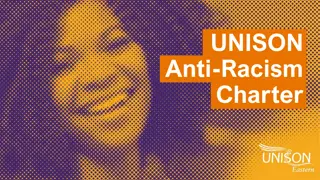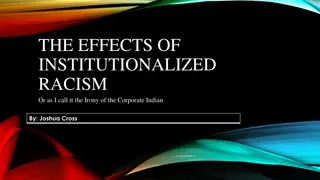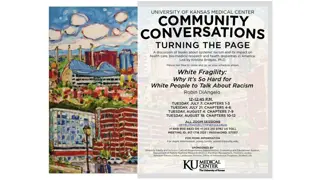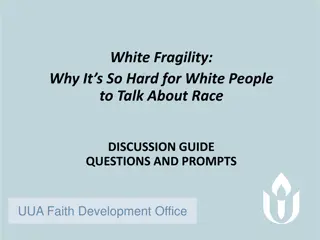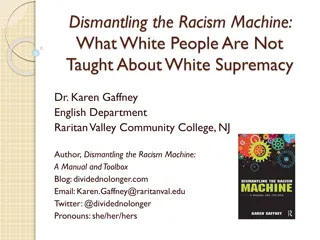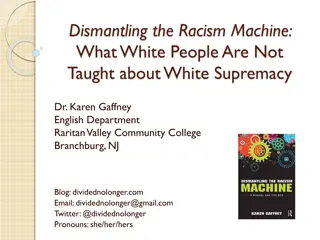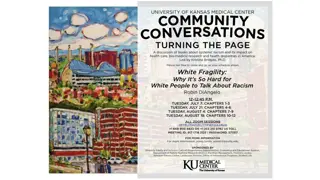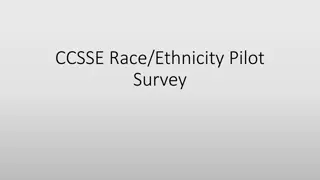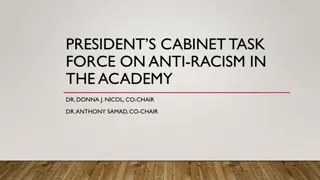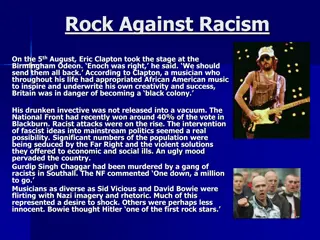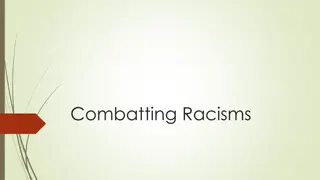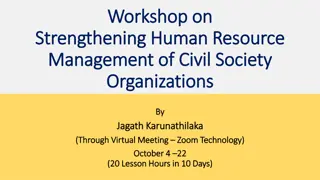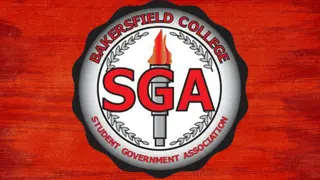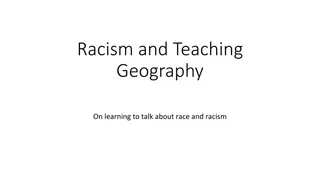Challenges and Rewards of Educating White Students about Racism
Dr. Alicia Dailey, an African American professor at a predominantly white institution, shares her experiences and reflections on educating white students about racism. The challenges faced by African American faculty in higher education include being underrepresented, rated unfavorably in evaluations, and dealing with psychological trauma. The community in North Manchester faces issues of racism and inadequate healthcare. Manchester University's culture highlights the lack of diversity and challenges faced by African American faculty members.
Download Presentation

Please find below an Image/Link to download the presentation.
The content on the website is provided AS IS for your information and personal use only. It may not be sold, licensed, or shared on other websites without obtaining consent from the author.If you encounter any issues during the download, it is possible that the publisher has removed the file from their server.
You are allowed to download the files provided on this website for personal or commercial use, subject to the condition that they are used lawfully. All files are the property of their respective owners.
The content on the website is provided AS IS for your information and personal use only. It may not be sold, licensed, or shared on other websites without obtaining consent from the author.
E N D
Presentation Transcript
The Challenges and Rewards of Educating White Students about Racism: Experiences & Reflections of an African American Professor at a Predominantly White Institution Dr. Alicia Dailey Assistant Professor of Social Work Manchester University February 21, 2020
Challenges African American Faculty in Higher Education Face (Brief Overview from the Literature) Underrepresented in higher ed (2% each for AA males & females) and concentrated in the lower professorial ranks Assigned high numbers of AA advisees and diversity committee work on top of other service obligations Rated unfavorably compared to their white counterparts on student teaching evaluations used for retention and promotion purposes
Challenges African American Faculty in Higher Education Face (Brief Overview from the Literature), Cont. Rated as less intelligent than white faculty Psychological trauma of tokenism. Publishing requirements favor white scholars (certain journals; quantitative studies)
Community of North Manchester North Manchester s population: 5838 (2017) North Manchester and Wabash: possible former sundown towns. Huntington: confirmed former sundown town (Definition of a SDT from Dr. James Loewen, sociologist: it must have <0.1% black residents for a period of time, and there must be evidence that that low proportion is purposeful. ). See link later in the presentation. Incident at McDonald s in Fall 2018: African American students reported having food thrown at them by the manager who stated her dislike for African Americans. My experiences with inadequate health care in North Manchester.
Culture at Manchester University Undergraduate fulltime enrollment: 1078;* many students come from rural Indiana. First Name Culture (I decided to compromise) 24.7% of all students (both undergraduate and graduate) are domestic students of color; 23.9% of undergraduate students are students of color. Int l students make up 2.5% of all students.* 102 fulltime faculty.* While there are other faculty of African descent, I m the only African American faculty whose country of origin is the U.S. Source for college stats: MU s 2019 Factbook, pp. 12, 24-26
Culture at Manchester University, Cont. Generally friendly students, faculty and staff; very supportive department More inclusive of LGBTQ individuals than other church-affiliated schools in the region No ethnic hair care available on campus or in NM; black barber & beautician are brought once/month from Ft. Wayne. African American students report that white students still use the N word even after the university president stated at a convocation that it would not be tolerated. First Amendment (free speech) Fifth Amendment (right to privacy) Prohibited behavior in student handbook
Question for Brief Discussion How does your campus handle the use of the N word by white students to refer to African American students? What actions, if any, are taken?
Courses I Teach that Contain Specific Content about Racism Introduction to Social Work taught every semester Racial, Ethnic and Gender Inequality (Sociology) taught in Spring 2019 and Jan 2020. Will be taught each term from Fall 2020 onward. Kudos to Prof. Pat Ashton (retired) for his collegiality. Social Welfare Policy (Social Work) taught every spring.
Classroom Approach First day: I tell students that this may be the first time they ve had an African American professor and that they need to hear this perspective. I state my preference for being addressed as Prof. Dailey and not by my first name (Sometimes I explain the history). When introducing myself, I usually state that I have earned 3 master s degrees in addition to my Ph.D. Except for athletic wear to promote school spirit, I dress in business to business casual clothes no blue jeans (tip from black professor in my Ph.D. program)
Classroom Approach, Cont. I explain to white students that they may feel uncomfortable, and that they may feel white guilt. I tell them that they re not responsible for the actions/attitudes of white people in the past. However, they are responsible to use their white privilege to promote justice for racial minorities. I tend to over-prepare for class sessions I haven t taught much so that I don t lose credibility. Lack of confidence is one of the results of internalized racism. Discussion and debate formats let students challenge each other
Challenges & Criticism Most common challenge: students either not taking my classroom policies seriously or pushing back on them (Ex: attendance, late assignments) White students asking for special treatment (Ex: I need to make a certain score on this assignment; Would you reopen the online exam? or coming in the first day of class and telling me to sign a form to let them in the class. ) Criticism of not being fair because I wouldn t change a policy just for that student.
Concepts (Partial List) Taught About Racism Institutional vs. Interpersonal Racism Intent vs. Impact Social construction of race and history of racial categories White privilege Intersectionality Religion & Racism Domination, exploitation, marginalization, hegemony
Concepts (Partial List) Taught About Racism, Cont. Social Darwinism (Racist) Original Purpose of Statue of Liberty Fallacies about Racism White Fragility/White Guilt
Content Delivery Storytelling Discussion & informal debates (Small group and large group) Scheduled debates about immigration and affirmative action Lecture (PowerPoints) that reviewed the readings Current Events (from politics to Dr. Phil to music videos) Video Clips (See next slide for examples) Interactive Websites (e.g., list of sundown towns): https://sundown.tougaloo.edu/sundowntownsshow.php?state=IN Privilege Walk (designed by honors student) E-discussions
Content Reflection: Excerpts from Students Journals
Clip Examples Current Events (from politics; 6:38 min.): https://www.cnn.com/videos/politics/2019/02/27/rashida-tlaib-mark- meadows-elijah-cummings-michael-cohen-testimony-sot-vpx.cnn The Unequal Opportunity Race (4:21 min.): https://www.youtube.com/watch?v=bcs_kcXleqE Equality vs. Equity (2:48 min.): https://www.youtube.com/watch?v=lrKRm6KAzfU Blue Eyes Brown Eyes Exercise by Jane Elliott (53:05 min.): https://www.pbs.org/video/frontline-class-divided/ Interview with Jane Elliott (9:20 min.): https://www.youtube.com/watch?v=jJuG26-4XUQ
Contentious Issues Talking, Acting, Dressing White or Black I treat everyone the same (Colorblindness) Comparing Oppressions (Whose oppression is worse?) Debate about Affirmative Action
Chatter about Racial, Ethnic & Gender Inequality Course Students talked about this course (Spring 2019) on social media as late as last fall (from the spring course) about the intensity of the debates. A student whom I didn t know walked up alongside me and stated that she wished she could be part of the discussions.
Crises & Their Resolutions 1. A few white students in the Spring 2019 SOC 228 class circulated a rumor that only black students could talk to me. Resolution: After speaking with some relatives & colleagues, I decided to do nothing. About 2 weeks later, white students affirmed my teaching abilities in class. 2. Clash between an African American male student and a white female student led to 2 females (one, a person of color and the other, white) not wanting to come to class anymore. Resolution: I got the 4 students together over pizza and facilitated conflict resolution.
Choices When to challenge/correct, and when to use restraint (I had to balance creating a safe space for all to express their opinions, and yet confront racist attitudes. Some students felt I didn t confront enough.). When to intervene in heated discussions between students Whether to respond to microaggressions I experience from students, and if so, how to respond. This can be exhausting! How much to share from my personal life
Changes in Students Minority students (and women) felt empowered to share their opinions. White students indicated that they learned from the diverse opinions shared in class. Some white students indicated that they were more aware of injustice than before, and felt that they could speak up. Others appeared to not change (ex: discounting black people s accounts of racism in their hometown). Senior student who had just completed SOC 228 was going to start a new job as a police officer the next week and said that this was one of the most meaningful classes in his MU education.
CLASS OF JAN 2020: RACIAL, ETHNIC & GENDER INEQUALITY
Content Applicability to Other Disciplines and Professions How do you teach about institutional racism in your discipline?
Comments? Questions? Contact Information: Alicia Dailey, Ph.D. aldailey@manchester.edu (260) 982-5366 office; (502) 836-0144 cell
References Alexander, R. and Moore, S. E. (2008). The Benefits, Challenges, and Strategies of African American Faculty Teaching at Predominantly White Institutions. Journal of African American Studies Vol. 12, pp. 4 18. Allison, D. C. (2008). Free to Be Me?: Black Professors, White Institutions. Journal of Black Studies, Vol. 38 (4), pp. 641-662. Hendrix, K. G. (1997). Student perceptions of verbal and nonverbal cues leading to Black and White professor credibility. The Howard Journal of Communications, Vol. 8, pp. 251-273.
References, Cont. Pittman, C. T. (2012). Racial Microaggressions: The Narratives of African American Faculty at a Predominantly White University. The Journal of Negro Education , Vol. 81(1), 82-92. Retrieved from https://www.jstor.org/stable/10.7709/jnegroeducation.81.1.0082 U.S. Department of Education, National Center for Education Statistics. (2019). The Condition of Education 2019 (NCES 2019- 144), Characteristics of Postsecondary Faculty. Retrieved from https://nces.ed.gov/fastfacts/display.asp?id=61


